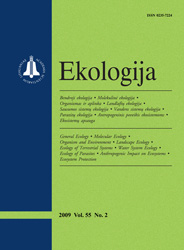 ISSN 0235-7224 ISSN 2029-0586 (online) |
2007 m. Nr. 2.priedas Sustainable development of the Lithuanian Geographic
Information Infrastructure
Geographic information (GI) has a tremendous economic and social value for any society. GI is very expensive to collect, process and maintain, yet ever easier to disseminate cheaply via Web-based services and products. Much GI is collected by local and national governments for specific purposes. One of the most valuable resources of a nation is its data. Not only the need for data sharing is important for everyday business processes, but it shows its value in decisionmaking phases during ecological disasters where efficiency means life and property saving. The main aim of the LGII (Lithuanian Geographic Information Infrastructure) is to develop an official Geographic Information source system, or Infrastructure, and Information Environment allowing a free incorporation of GI into almost any Public Sector Information (PSI) services in Lithuania. One of the goals of LGII is an open, shared infrastructure for accessing and distributing information products and services online. To achieve this goal, data residing at regional and national organisations are to be harmonized with common standards. The overall goal of LGII is to improve the quality of policy making, citizen’s participation in the society life and market development through the increased use of GI, hence to provide a new means of acquiring knowledge. The LGII as part of Information Technology is a knowledge-gathering activity by its geographic nature. It is one of the effective components of the physical and economic infrastructure ensuring a stable and balanced development of the economy and its efficient functioning. The issue for all the countries is not to ask the question whether a National GII should be implemented; the challenge is how to implement it in an effective way based on culture, specific requirements, the priorities and history of the country to promote its economic development, to stimulate its better government and to foster environmental sustainability. Keywords: geographic information, sustainable development, GIS, geographic information infrastructure, spatial data infrastructure, ecological factors |
Issues:
2011 - Vol.57 No. 1, No. 2 2010 - Vol.56 No. 1-2, No. 3-4 2009 - Vol.55 No. 1, No. 2, No. 3-4 2008 - Vol.54 No. 1, No. 2, No. 3, No. 4 2007 - Vol.53 No. 1, No. 2, No. 2.priedas, No. 3, No. 4 2006 No. 1, No. 2, No. 3, No. 4 2005 No. 1, No. 2, No. 3, No. 4 2004 No. 1, No. 2, No. 3, No. 4 2003 No. 1, No. 2, No. 3, No. 4 2002 No. 1, No. 2, No. 3, No. 4 2001 No. 1, No. 2, No. 3, No. 4 |